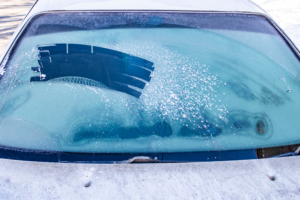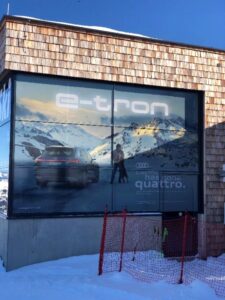For most of us in the large format graphics community, we typically look forward to an increase in business in the fall and winter months. While 2020 was anything but typical, for some it can among the busiest time of the year. In more typical years, this watershed of graphic business comes in many forms, from retail promotions and trade shows, to sporting, entertainment, and holiday events.
As much as we enjoy the increase in business, the winter season does come with one caveat: winter weather conditions. As temperatures drop and the snow starts to fly, inclement weather can present unique challenges for the graphics producer/installer. Conditions such as cold, rain, ice, sleet, and snow can affect a graphic's durability, aesthetics, installation, and removal. This is especially true for flexible, adhesive backed graphics. Weather can affect the look, longevity, installation, and removal.

A great way to mitigate risk is to engage a best-practices strategy when tasked with producing and installing graphics in extreme winter weather conditions. Things to consider include, graphic use, substrate selection, finishing options, and installation. Considering these issues methodically ensures a graphic that looks good, hold up, and will provide a worry-free experience.
Graphic Use
How will the graphic be used? Will it be on a building, a bus, or a window? Will it be completely exposed to the weather or have some sort of protection? Vertical or horizontal application? The type of usage is the first and most important question to ask, as the answers will be determining factors for all other aspects of the construction, printing, and installation. Especially in winter, weather conditions can add strain on graphics, so it is important to consider where and how the graphic will be used. For example, a graphic on the outside of a vehicle will encounter road salt, rain, snow, dirt, potential washing, and scratching. This type of graphic will require a much more robust construction than a window graphic sheltered from the weather by an overhang. Understanding, and anticipating, how and where the graphic will be used is a crucial first step to creating a product that will meet a customer’s expectation.
Substrate Selection
For graphics subjected to extreme weather conditions, the type of substrate(s) used is vital in determining the durability and performance of the graphic. For flexible vinyl, a polymeric vinyl or cast vinyl is a great choice. The molecular make up of these products allows extended life and durability in extreme weather, as well as being better-suited to the expansion and contraction that occurs with major temperature changes. These types of vinyl will outlast a standard monomeric PVC. Additionally, the type of adhesive used can play a crucial role in the installation, removal, and longevity of the graphic. Can the adhesive be installed in extreme weather conditions, or do you have to wait for compliant weather to install? Most adhesives install best in temperatures above +10°C (+50°F). Is a solvent-based adhesive better suited than a water-based adhesive for the application? Solvent-based adhesives can be a better choice than water-based in some harsh environments.
Finishing
For this article, finishing refers specifically to the usage of lamination films. An over-laminating film gives the graphic an added layer of protection. This includes protection from ink fade, substrate degradation, cleaning, road salt, etc. Choosing the laminate to use is as important a decision as choosing the printable
substrate itself. Once the printable substrate choice is made based on the expected conditions, the overlaminate should be matched to the substrate. For example, laminating a polymeric, calendared substrate with a polymeric, calendared overlaminate is good choice. The materials will expand and contract in a similar fashion, as well as have similar longevity characteristics. The key is to determine the desired level of added protection and use a laminate that complements the substrate.
Installation
Our installation professionals are the last (but not least) part of our graphics journey. The installer is the last one to handle the graphic, taking the fruits of the print professional’s labor - a great looking print - and get it displayed in a way that gets it noticed. A major consideration during the installation process is when, where and how the graphic will be installed. Sometimes, the graphic needs be installed in inclement weather, and the installer cannot wait for the weather to cooperate. While most installers have tried and true methods to deal with a multitude of conditions, there are a few things to consider when planning the installation. Can the product be installed in extreme weather conditions? Can we alter the graphic location (i.e., on a window, inside mount in lieu of outside mounting) to accommodate the conditions? Is the installation on a tight schedule, or do we have time if the weather delays installation? If we anticipate the installation conditions, we can pivot to products or methods to ensure a smooth and timely installation.
A word of caution. Some may simply default to a high-performance solution for all applications. Though this may ensure a tough graphic, regardless of environment, it isn’t necessarily a good choice. Over-engineering every job will put your business at a competitive disadvantage. For example, some short-term outdoor or event graphics may only require an economical solution. Using too robust materials or adding laminate when not required will add unnecessary time and cost. The key is educating yourself on the array of products on the market to engineer the optimal solution for each unique project.
CONTINENTAL GRAFIX OFFERS COLD WEATHER SOLUTIONS
X-Treme is a smooth, white calendared, polymeric vinyl film backed with a proprietary removable adhesive. The adhesive is specially formulated for installation in extreme temperature conditions. Well-suited for low-surface energy substrates, it can be installed in temperatures from -15°C to + 38°C (5°F to over 100°F). No need to wait for the weather to cooperate. It has an outdoor longevity of 5 years (or longer with proper over-laminate).

Innova Ice is the only outside mount one-way vision film that can be applied in cold weather. This 2-year PVC-based perforated window film is backed with specially engineered adhesive that allows installation in temperatures as low as -15°C (5°F). Innova Ice provides another example of having choosing the right material for the environment. There are times a client can’t wait for the weather to cooperate for graphics installation, and Innova Ice delivers a robust solution that will hold up in tough conditions.
panoRama Film is a PVC-free, non-adhesive, interior mount, perforated window film. One way to deal with cold weather issues is to avoid them completely. Mounting this product on the inside of your window, and you will have a long-lasting one-way perforated window solution. panoRama Film is 100% polyester (PVC-free), so you have the added benefit of being green.... a good thing for any season!
panoRama Protect & panoRama Cast are calendared and cast gloss PVC over-laminating films, respectively, coated with a solvent-based permanent adhesive. With outdoor ratings of 1 and 2 years, panoRama Innova Ice they add a high level of protection, especially in harsh weather. With superior optical clarity, they add to the aesthetic of your graphic. Bonus feature: they also are printable and work great as a window film too!
Finally, investing the additional time anticipating the conditions for your project by asking the probing questions and choosing the correct solutions will result in meeting and, hopefully, exceeding expectations. This will help ensure quality work and a satisfied, repeat customer!
Text by: Wayne Colbath